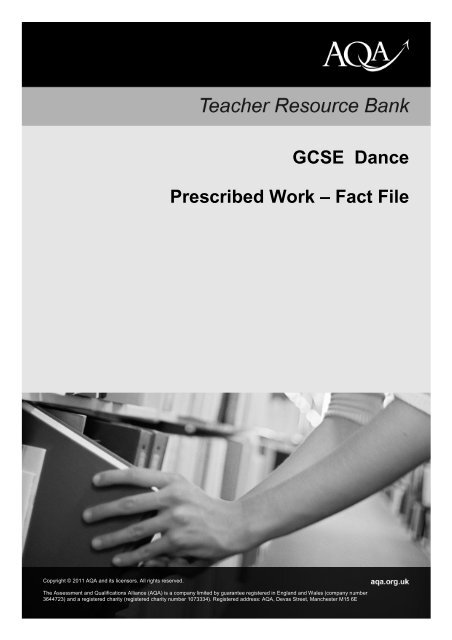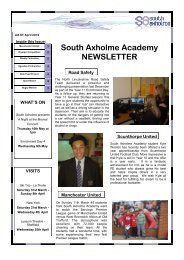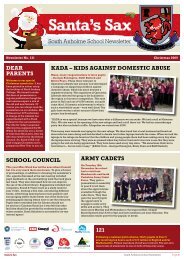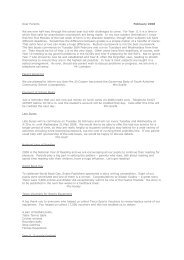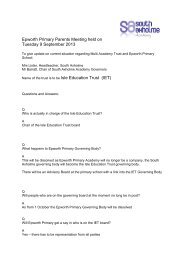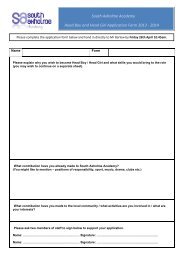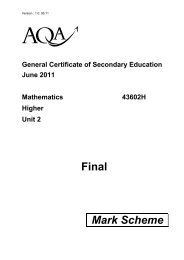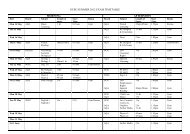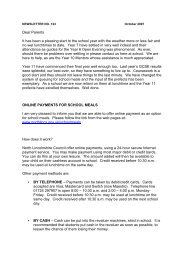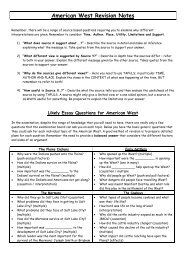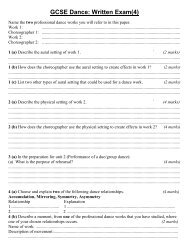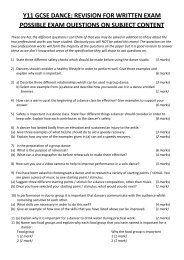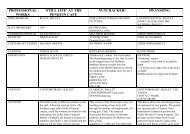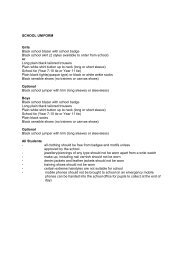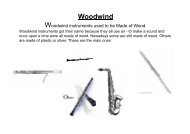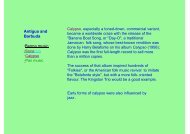10 Professional Works Revision Pack - South Axholme Academy
10 Professional Works Revision Pack - South Axholme Academy
10 Professional Works Revision Pack - South Axholme Academy
Create successful ePaper yourself
Turn your PDF publications into a flip-book with our unique Google optimized e-Paper software.
GCSE Dance<br />
Prescribed Work – Fact File<br />
Copyright © 2011 AQA and its licensors. All rights reserved.<br />
The Assessment and Qualifications Alliance (AQA) is a company limited by guarantee registered in England and Wales (company number<br />
3644723) and a registered charity (registered charity number <strong>10</strong>73334). Registered address: AQA, Devas Street, Manchester M15 6E
Teacher Resource Bank / GCSE Prescribed <strong>Works</strong> Fact File / Version 1.1<br />
This fact-file provides key facts and information about the<br />
prescribed professional works that were available for<br />
purchase on DVD or video when the specification was<br />
written in 2008. This is “at a glance” information for<br />
teachers. Students will need to learn more about each<br />
dance to enhance their practical work and prepare for the<br />
written paper. This information can be found in the<br />
resources provided by many of the dance companies and<br />
independent authors.<br />
Updated April 2011<br />
Copyright © 2011 AQA and its licensors. All rights reserved.<br />
2
Teacher Resource Bank / GCSE Prescribed <strong>Works</strong> Fact File / Version 1.1<br />
Contents<br />
And Who Shall Go To The Ball?................................................................................... 4<br />
Bird Song...................................................................................................................... 5<br />
Dance Tek Warriors...................................................................................................... 6<br />
Faultline........................................................................................................................ 7<br />
Ghost Dances............................................................................................................... 8<br />
Nutcracker!................................................................................................................... 9<br />
Overdrive.................................................................................................................... <strong>10</strong><br />
Perfect........................................................................................................................ 11<br />
Romeo and Juliet ....................................................................................................... 12<br />
Rosas Danst Rosas.................................................................................................... 13<br />
‘Still Life’ at the Penguin Café..................................................................................... 14<br />
Swansong................................................................................................................... 15<br />
Copyright © 2011 AQA and its licensors. All rights reserved.<br />
3
Teacher Resource Bank / GCSE Prescribed <strong>Works</strong> Fact File / Version 1.1<br />
And Who Shall Go To The Ball?<br />
Choreographer<br />
Company<br />
Date of first<br />
performance<br />
Dance style<br />
Choreographic<br />
style<br />
Theme<br />
Starting point<br />
Dancers<br />
Structure<br />
Accompaniment<br />
Costume<br />
Lighting<br />
Set<br />
Staging<br />
Contact<br />
Resources<br />
Rafael Bonachela<br />
CandoCo Dance Company<br />
April 2007 (reconstructed for film 20<strong>10</strong>)<br />
Contemporary with contact work. This performance features highly-skilled use of<br />
wheelchairs by both disabled and non-disabled dancers.<br />
Collaborative and task-based. Strong sense of connection. Cuts through space.<br />
Bonachela describes himself as a “movement junkie” – he explores and<br />
experiments with pure movement.<br />
“In a twisted ballroom bodies are laid out on an empty dance floor and entangled in<br />
dysfunctional chairs” Rafael Bonachela<br />
Movement-based tasks e.g. name solos, mix and match tasks and speed-dating.<br />
The title was the idea of the composer, Scott Walker. The title then further informed<br />
the choreography even though Bonachela had started to generate the movement<br />
material.<br />
7 (3 women and 4 men on DVD)<br />
4 “movements” that flow seamlessly<br />
Scott Walker; performed by London Sinfonietta<br />
Commissioned for the choreography. Sets the scene for a “sinister and primal” ball.<br />
Contemporary, edgy, staccato and uses silence.<br />
Torsten Neeland<br />
Black and red, slim-fitting. Men wear short-sleeved shirts and trousers. The women<br />
wear short, almost transparent dresses. Lines and blocks of colour dissect the lines<br />
of the body. Bare feet for most dancers, dance shoes are worn where necessary.<br />
Guy Hoare<br />
Changes for each section from dark to bright to dark. Used architecturally and<br />
sculpturally to dissect space. Varied, includes top lights, footlights and an abstract<br />
chandelier of tungsten lamps.<br />
Torsten Neeland<br />
A framed space (or box) defined by a white line, an abstract metal chandelier hangs<br />
up stage left to suggest a ballroom. Dysfunctional, abstract, metal chairs reference<br />
the idea of cutting space.<br />
Filmed in a dance studio-theatre but originally created for a mid-scale theatre<br />
stages.<br />
CandoCo Dance Company<br />
2T Leroy House<br />
436 Essex Road<br />
London N1 3QP<br />
Email: info@candoco.co.uk<br />
www.candoco.co.uk<br />
Written resource pack & DVD with choreographic tutorials available from company.<br />
Copyright © 2011 AQA and its licensors. All rights reserved.<br />
4
Teacher Resource Bank / GCSE Prescribed <strong>Works</strong> Fact File / Version 1.1<br />
Bird Song<br />
Choreographer<br />
Company<br />
First<br />
performance<br />
Dance style<br />
Choreographic<br />
style<br />
Theme<br />
Starting point<br />
Siobhan Davies<br />
Siobhan Davies Dance Company<br />
3 April 2004 (world premiere)<br />
Contemporary, release-based<br />
Abstract. Collaborative – dancers create their initial material and roles. Movement,<br />
sound and design closely relate.<br />
Movement responding to sound, inner rhythms, territory, signals<br />
The call of the Pied Butcher bird; dance/music relationship; in-the-round<br />
performance; the central solo.<br />
Dancers<br />
Structure<br />
5 women, 3 men<br />
16 sections. Central solo choreographed first. Most of the sections in the first half<br />
are repeated and developed in the second part, in reverse order.<br />
Accompaniment<br />
Andy Pink (sound and music designer)<br />
A collage of natural and found sounds, digital samples, classical and jazz music,<br />
and silence<br />
Costume<br />
Genevieve Bennett<br />
Vests and loose trousers in whites, blues and greys, with glimpses of lemon, adapt<br />
to the lighting and enhance the movement.<br />
Lighting<br />
Adrian Plaut<br />
Video projection is used as a light source and creates patterns and textures on the<br />
floor. Lights set above the audience illuminate the stage and the dancers.<br />
Set<br />
Visual artists David Ward and Sam Collins<br />
Patterns and effects are projected on the square dance floor.<br />
Staging<br />
In the round on the DVD (also reworked for proscenium arch)<br />
Contact<br />
Resources<br />
Siobhan Davies Dance Company<br />
85 St George’s Road, London, SE1 6ER<br />
Tel: 0207 091 9650<br />
Email: info@siobhandavies.com<br />
www.siobhandavies.com<br />
Company resource pack can be downloaded from website<br />
Birdsong resource pack by Lorna Sanders (NRCD)<br />
DVD - order from website<br />
Interactive guide: www.arts-pool.co.uk<br />
Copyright © 2011 AQA and its licensors. All rights reserved.<br />
5
Teacher Resource Bank / GCSE Prescribed <strong>Works</strong> Fact File / Version 1.1<br />
Dance Tek Warriors<br />
Choreographers<br />
Company<br />
First<br />
performance<br />
Dance style<br />
Choreographic<br />
style<br />
Theme<br />
Doug Elkins, Michael Joseph, Charemaine Seet.<br />
Artistic Concept: Corrine Bougaard<br />
Union Dance<br />
12 February, 1998 (London premiere)<br />
A mixture of contemporary (release and Cunningham), hip hop, Arabic, Asian,<br />
Capoeira and martial arts influenced styles.<br />
Thematic and episodic<br />
Warriors, journeys, spiritual paths, life’s struggles.<br />
“The Spirit of the Dance is inseparable from the human condition”<br />
Starting point<br />
Tekken – a Sony PlayStation game<br />
Dancers<br />
Structure<br />
Accompaniment<br />
Costume<br />
Lighting<br />
3 women , 3 men<br />
3 sections, each by a different choreographer and representing part of the journey<br />
towards becoming a warrior:<br />
1. Mass Equilibria in the Sea of Tranquility (Joseph); 2. Three Young Blades (Seet)<br />
3. Bright Flames in Dark Waters (Elkins)<br />
Various, including DJ Shadow, Beethoven, Tunde Jegede, Arrested Development,<br />
David Byrne & Nusrat Fetah Ali Khan.<br />
An eclectic mix of music from different times and cultures.<br />
Ursula Bombshell<br />
Futuristic and loosely based on space princesses, heroes and warriors. Various,<br />
including close fitting tops, leotards, skirts, looser culottes and trousers. Sometimes<br />
men are bare-chested. In one section the dancers wear visors.<br />
Bill Deverson<br />
Lights highlight the dancers and create coloured washes on the floor and backdrop.<br />
Mainly blue or gold. In some sections dramatic silhouettes are projected; in others<br />
patterns are projected on the floor and backdrop.<br />
Set<br />
A simple set with a short film projection in section 2.<br />
Staging<br />
Proscenium<br />
Contact<br />
Resources<br />
www.uniondance.co.uk<br />
DVD & resource pack available from<br />
www.uniondance.co.uk<br />
interactive guide: www.arts-pool.co.uk<br />
Copyright © 2011 AQA and its licensors. All rights reserved.<br />
6
Teacher Resource Bank / GCSE Prescribed <strong>Works</strong> Fact File / Version 1.1<br />
Faultline<br />
Choreographer<br />
Shobana Jeyasingh<br />
Company Shobana Jeyasingh Dance Company<br />
First<br />
performance February 2007<br />
Dance style<br />
Combines elements of Bharata Natyam and contemporary, with some pedestrian<br />
gestures.<br />
Choreographic<br />
style<br />
Theme<br />
Narrative and cinematic, combines the everyday with classical Indian mythology.<br />
Youth culture, gender stereotypes, gangs, city life.<br />
Starting point<br />
Londonstani, a novel by Gautam Malkhani. Peter Gomes’s film. Music by Scanner<br />
Structure<br />
Film prologue; three dance sections; film.<br />
Dancers<br />
Accompaniment<br />
Costume<br />
Lighting<br />
Set<br />
Staging and<br />
Film<br />
Contact<br />
Resources<br />
3 women and 4 men on DVD. 4 women and 4 men in live performances.<br />
Scanner (composer and sound artist) and Errolyn Wallen (composer for live voice).<br />
Soprano: Patricia Rozario<br />
Live and recorded solo voice with recorded sounds inspired by Bach and city life.<br />
Ursula Bombshell<br />
Urban and sophisticated. Shades of black and grey with brightly coloured ties for<br />
the men. Variety of textures in women’s costumes: metallic, shiny, flimsy. Each is<br />
different.<br />
Lucy Carter<br />
Inspired by the film and street images. Highlights tension and the urban<br />
environment. Enhances the film idea by zooming in, panning out and ‘painting’ the<br />
screen. Floor lights define the space and harshly light the dancers.<br />
Dick Straker<br />
A curved wall provides a surface for the film projection and conceals or reveals the<br />
singer. Two curved areas (one large and one narrow) are created for the dancers.<br />
Proscenium with film.<br />
Black and white film, shot by Pete Gomes, is projected in two sections:<br />
documentary style, young men in the street and Patricia Rozario.<br />
Shobana Jeyasingh Dance Company<br />
Moving Arts Base, Syracusae, 134 Liverpool Road, Islington, London, N1 1LA<br />
Tel: 0207 697 4444<br />
Email: education@shobanajeyasingh.co.uk<br />
www.shobanajeyasingh.co.uk<br />
Resource pack available from company website<br />
DVD – education@shobanajeyasingh.co.uk<br />
Interactive guide: www.arts-pool.co.uk<br />
Copyright © 2011 AQA and its licensors. All rights reserved.<br />
7
Teacher Resource Bank / GCSE Prescribed <strong>Works</strong> Fact File / Version 1.1<br />
Ghost Dances<br />
Choreographer<br />
Christopher Bruce<br />
Company Various, including Rambert Dance Company<br />
First<br />
performance 3 July, 1981<br />
Dance style<br />
A blend of contemporary (Graham-influenced) and ballet with elements of folk and<br />
social styles.<br />
Choreographic<br />
style<br />
Theme<br />
Thematic and episodic with narrative elements. Strong characterisation<br />
Political oppression in Chile<br />
Starting point<br />
The music and <strong>South</strong> American rituals and culture.<br />
Structure<br />
Seven sections, each characterised by a different piece of music or song.<br />
Dancers<br />
Accompaniment<br />
Five women and six men<br />
<strong>South</strong> American songs and folk tunes by Inti-Illamani (Arranged by Nicholas<br />
Mojsiejenko) and wind effects<br />
Costume<br />
Belinda Scarlett<br />
Ghosts wear wigs and rags and have skull-like masks and bodies painted to<br />
suggest bones and muscles. The Dead wear gender-specific, everyday clothes<br />
suggesting different walks of life, each wears a unique costume.<br />
Lighting<br />
Nick Chelton<br />
Gloomy and shadowy, side lighting highlights the ghosts. Brighter for folk-type<br />
dances performed by the Dead. Lighting changes signify deaths.<br />
Set<br />
Christopher Bruce<br />
The painted backdrop represents a rocky plain and a cave opening. In the distance<br />
there is water and mountains. There are rock-like structures on stage.<br />
Staging<br />
Contact<br />
Resources<br />
Proscenium<br />
Rambert Dance Company<br />
94 Chiswick High Road, London, W4 1SH<br />
Tel: 0208 630 0615<br />
Email: learning@rambert.org.uk<br />
www.rambert.org.uk<br />
Study notes available from Rambert Learning & Participation<br />
DVD not currently available<br />
Copyright © 2011 AQA and its licensors. All rights reserved.<br />
8
Teacher Resource Bank / GCSE Prescribed <strong>Works</strong> Fact File / Version 1.1<br />
Nutcracker!<br />
Choreographer<br />
Matthew Bourne<br />
Company First performed by Adventures in Motion Pictures, now performed by New<br />
Adventures<br />
First<br />
performance August 1992<br />
Dance style<br />
Contemporary and balletic. Exaggerated but realistic use of gestures.<br />
Choreographic<br />
style<br />
A reworking of a traditional ballet. Narrative and comic. Influenced by film and<br />
theatre. Close relationship between dance and music.<br />
Theme<br />
The Nutcracker story retold with references to adolescence, escapism, fantasy and<br />
satire.<br />
Starting point<br />
The classical ballet and the music. Images of Victorian childhood<br />
Structure<br />
Two acts with nine episodes (original version).<br />
Dancers 24<br />
Pyotr Ilyich Tchaikovsky<br />
Accompaniment<br />
Classical, orchestral. Composed in 1892 for the original Ivanov ballet.<br />
Costume<br />
Lighting<br />
Anthony Ward<br />
Colourful and ‘over the top’ to show characters. Cultural influences and literal<br />
references to sweets.<br />
Howard Harrison<br />
Theatrical, helps to create atmosphere<br />
Set<br />
Anthony Ward<br />
Partly realistic but larger than life and almost cartoon-like. Scene 1 is an austere,<br />
drab orphanage with iron beds. There is an interval scene on a frozen lake and<br />
Scene 2, entered through a large mouth, represents Sweetieland – complete with a<br />
massive three-tier wedding cake.<br />
Staging<br />
Scenario<br />
Contact<br />
Resources<br />
Proscenium<br />
Matthew Bourne and Martin Duncan<br />
New Adventures<br />
c/o Sadlers Wells, Rosebery Avenue, London, EC1R 4TN<br />
Email: helen@new-adventures.net<br />
www.new-adventures.net/rebourne<br />
Nutcracker! resource available on-line<br />
Nutcracker! By Lorna Sanders (NRCD)<br />
DVD from Amazon or Play.com<br />
Copyright © 2011 AQA and its licensors. All rights reserved.<br />
9
Teacher Resource Bank / GCSE Prescribed <strong>Works</strong> Fact File / Version 1.1<br />
Overdrive<br />
Choreographer<br />
Richard Alston<br />
Company Richard Alston Dance Company<br />
First<br />
performance October 2003<br />
Dance style<br />
Contemporary, Cunningham-influenced and release-based. The torso tips, tilts,<br />
twists and curves. Movement is expansive and energetic.<br />
Choreographic<br />
style<br />
Pure dance – concerned with the movement itself. Alston works collaboratively with<br />
the dancers to create the material. Music and dance have a close relationship.<br />
Alston describes his approach as ‘architectural’, he likes structure and pattern.<br />
Theme<br />
Starting point<br />
Not specified<br />
Music, movement and space.<br />
Structure<br />
Dancers<br />
Accompaniment<br />
Costume<br />
Lighting<br />
16 chapters<br />
6 women and 5 men<br />
Keyboard Study # 1 by Terry Riley. The pianist is Steffan Schleirmacher<br />
Minimalist. Written for two keyboard players and structured by computer. Phrases<br />
or fragments of melody interact and get shorter and shorter, stopping abruptly after<br />
21 minutes.<br />
Jeanne Spaziani<br />
Simple, elegant, gender-specific costumes enhance the body design and flow of the<br />
movement. Men wear grey loose fitting vests and trousers. Women wear halterneck<br />
tunics and trousers; three are all in red and three wear red and grey tunics<br />
and grey trousers.<br />
Charles Balfour<br />
The floor is washed in shades of blue, grey and purple. Colour changes relate to<br />
sections of the dance. Lighting from above and the sides create shadows.<br />
Set<br />
The simple set consists of a rectangular space, with white borders at the sides and<br />
back. The back wall is black. There are no wings and dancers exit and enter from<br />
the sides.<br />
Staging<br />
Contact<br />
Resources<br />
Theatrical<br />
Essential Alston, The Place, 17 Duke’s Road, London, WC1H 9PY<br />
Tel: 0207 121 <strong>10</strong>30<br />
Email: learning@theplace.org.uk<br />
www.theplace.org.uk<br />
Into Overdrive resource pack available from The Place<br />
DVD available from The Place<br />
Copyright © 2011 AQA and its licensors. All rights reserved.<br />
<strong>10</strong>
Teacher Resource Bank / GCSE Prescribed <strong>Works</strong> Fact File / Version 1.1<br />
Perfect<br />
Choreographer<br />
Kevin Finnan and the dancers<br />
Company Motionhouse<br />
First<br />
performance January 2005<br />
Dance style<br />
Choreographic<br />
style<br />
Theme<br />
Combines dance theatre and aerial work. Strong physicality and contact work. Style<br />
uses and defies gravity.<br />
Physically adventurous and ‘filmic’. Strong emotional content. Finnan always begins<br />
with the set. Collaborative.<br />
The way we witness time and how as a force it pulls and shapes us, drawing upon<br />
the concepts of waiting, nurturing, time flying by and the aging process.<br />
Starting point<br />
Space and time. A book called The History of Barbed Wire<br />
Structure<br />
Dancers<br />
Accompaniment<br />
Costume<br />
Lighting<br />
Set<br />
Staging and<br />
Film<br />
Contact<br />
Resources<br />
13 sections<br />
3 women & 2 men<br />
Sophy Smith and Tim Dickinson<br />
A mixture including percussion, voice, electric guitar. Creates atmosphere,<br />
sometimes matching and sometimes contrasting with the movement content<br />
Claire Armitage<br />
Simple, everyday, gender-specific. Men wear white shirts and black trousers.<br />
Women wear short, strappy, black dresses. Clean lines and shapes, adapted to<br />
work around harnesses for flying.<br />
Mark Parry<br />
The lighting works with the film and the set, sometimes sharpening the focus, other<br />
times layering the image. In some sections lighting divides the floor space and<br />
creates shadows. In other sections purple and gold lights achieve a bright, colourful<br />
effect.<br />
Simon Dormon<br />
Box frame set: a white box gradually revealing a wire cage. Many different uses.<br />
Set includes projection, sand, a paper screen, water, a gauze screen and slings.<br />
Rakes and brooms are used as props.<br />
Theatrical<br />
Film by Caroline Bridges.<br />
Film within performance adds another layer to the choreography and meaning. Film<br />
is used to set the scene, light the dancers and interact with the dancers.<br />
Spencer Yard, Leamington Spa, Warwickshire, CV31 3SY<br />
Email: info@motionhouse.co.uk<br />
www.motionhouse.co.uk<br />
Perfect education pack including interviews with Kevin Finnan and choreographic<br />
DVD available on-line and from Motionhouse.<br />
DVD & CD available from Motionhouse<br />
Interactive guide: www.arts-pool.co.uk<br />
Copyright © 2011 AQA and its licensors. All rights reserved.<br />
11
Teacher Resource Bank / GCSE Prescribed <strong>Works</strong> Fact File / Version 1.1<br />
Romeo and Juliet<br />
Choreographer<br />
Company<br />
First<br />
performance<br />
Dance style<br />
Choreographic<br />
style<br />
Theme<br />
Kenneth Macmillan<br />
Various, including The Royal Ballet and Birmingham Royal Ballet (BRB)<br />
February 1965 (Royal Ballet)<br />
June 1992 (Birmingham Royal Ballet)<br />
Ballet<br />
Narrative and dramatic. Macmillan explores behaviour and emotions in depth.<br />
Forbidden love, family conflict, growing up.<br />
Starting point<br />
Structure<br />
Shakespeare’s play<br />
Three Acts with 13 scenes<br />
Dancers<br />
A large cast including 14 soloists<br />
Accompaniment Serge Prokofiev’s Romeo and Juliet, Opus 64<br />
Costume<br />
Lighting<br />
Set<br />
Classical, orchestral.<br />
Nicholas Georgiadis (BRB version: Paul Andrews)<br />
Rich and lavish. Realistic, suggesting time, place and social class (Renaissance<br />
Italy).<br />
Original design by William Bundy, redesigned by John B Read (both versions).<br />
Theatrical. Suggests time of day. Used dramatically in night-time balcony and tomb<br />
scenes. The spotlight highlights the romantic duets between the lovers.<br />
Nicholas Georgiadis. (BRB version: Paul Andrews)<br />
Realistic, representing various locations, indoor and out. The main set is a timberframed<br />
structure on two levels with staircases, balconies, arches and doorways.<br />
The effect is grand, old and worn. Some features are significantly over-large such<br />
as birdcages in Juliet’s bedroom. A range of realistic props enhances characters<br />
and locations.<br />
Staging<br />
Contact<br />
Resources<br />
Proscenium<br />
The Royal Ballet<br />
Royal Opera House, Bow Street, Covent Garden, London, WC2E 9DD<br />
Tel: 0207 240 1200<br />
Email: education@roh.org.uk<br />
www.info.royaloperahouse.org/ballet<br />
Resource pack from The Royal Ballet<br />
Romeo and Juliet – Bringing the Ballet to Life resource from BRB<br />
DVD from Amazon, Play.com, Royal Opera House & Birmingham Royal Ballet<br />
(ensure you obtain Macmillan’s choreography).<br />
Copyright © 2011 AQA and its licensors. All rights reserved.<br />
12
Teacher Resource Bank / GCSE Prescribed <strong>Works</strong> Fact File / Version 1.1<br />
Rosas Danst Rosas<br />
Choreographer<br />
Anne Teresa de Keersmaeker.<br />
Company Rosas<br />
First<br />
performance 1983 (live performance). The filmed version was made in 1997<br />
Dance style<br />
Post-modern, physical with pedestrian actions and repetitive, compulsive gestures.<br />
Energetic and dynamic.<br />
Choreographic<br />
style<br />
Highlights single parts of the body, drawing attention to small human gestures.<br />
Movements are patterned and structured to create rhythms and achieve perfect<br />
unison.<br />
Theme<br />
Human behaviour, rage<br />
Starting point<br />
Structure<br />
Dancers<br />
Accompaniment<br />
Costume<br />
Lighting<br />
Set<br />
Staging and<br />
Film<br />
Contact<br />
Resources<br />
Music-dance relationships<br />
8 sections (film version); 5 sections (live version)<br />
Four women.<br />
Film includes inter-cut scenes with dancers from previous productions.<br />
Thierry de Mey and Peter Vermeersch<br />
Electronic, percussive, minimalist music together with the natural sounds of the<br />
dancers in action.<br />
Designed by Rosas<br />
Drab everyday grey skirts and tops, black leggings, socks and shoes. Loose fitting<br />
and functional. They appear institutional.<br />
Film: natural light through the windows.<br />
Live performance: Remon Fromont<br />
Film: takes place in the corridors and rooms of a large, austere, empty school in<br />
Belgium. Windows, doors and walls frame the action. An assortment of wooden<br />
chairs is used for one section.<br />
Live version: set by Keersmaeker<br />
Site-specific<br />
Film directed by Thierry de Mey. The camera becomes both composer and<br />
choreographer by taking us on a journey, panning and zooming, selecting and<br />
layering images to create rhythms.<br />
Rosas<br />
Van Volxemlaan 164, 1190, Vorst, Belgium<br />
Email: mail@rosas.be<br />
www.rosas.be<br />
DVD available from Amazon and Play.com<br />
Copyright © 2011 AQA and its licensors. All rights reserved.<br />
13
Teacher Resource Bank / GCSE Prescribed <strong>Works</strong> Fact File / Version 1.1<br />
‘Still Life’ at the Penguin Café<br />
Choreographer<br />
Company<br />
First<br />
performance<br />
Dance style<br />
Choreographic<br />
style<br />
David Bintley<br />
Birmingham Royal Ballet and The Royal Ballet<br />
March 1988 (The Royal Ballet)<br />
Modern ballet with a mix of social and cultural styles to suggest geographical<br />
locations. These include English Morris, Latin American carnival and African. There<br />
are also references to contemporary and post-modern dance.<br />
Episodic. Combines a range of styles and cultural influences to tackle a political<br />
theme. Theatrical, using characterisation and humour to good effect.<br />
Theme<br />
Endangered species.<br />
Starting point<br />
The music and the album cover. The Doomsday Book of Animals by David Day.<br />
Structure<br />
Dancers<br />
Accompaniment<br />
Costume<br />
Lighting<br />
Set<br />
Eight scenes (DVD).<br />
Nine soloists plus corps de ballet<br />
Composed by Simon Jeffes for the Penguin Café Orchestra.<br />
Re-orchestrated for the Royal Opera House/Birmingham Royal Ballet orchestras.<br />
Orchestral, combining classical, rock and country influences.<br />
Hayden Griffin<br />
Combine animal and human characteristics in a dream-like way. Masks and<br />
headdresses have animal features such as curly horns and antennae. Costumes<br />
and accessories have cultural and social references.<br />
John B Read<br />
Lighting indicates beginnings and ends of acts. Follow-spots highlight the dancers.<br />
Colour is used to enhance the mood. Bright in the first half and dramatic towards<br />
the end.<br />
Hayden Griffin<br />
Set in a café with chairs and tables. After the open scene the rest of the dances<br />
take place on bare stage. Props include waiter’s trays. Ever-changing colourful<br />
backdrops give a sense of environment, climate and scale.<br />
Staging<br />
Contact<br />
Resources<br />
Proscenium<br />
Birmingham Royal Ballet<br />
Birmingham Hippodrome, Thorp Street, Birmingham, B5 4AU<br />
Tel: 0121 245 3500<br />
Email: education@brb.org.uk<br />
www.brb.org.uk<br />
Resource pack available from Birmingham Royal Ballet.<br />
David Bintley’s ‘Still Life’ at the Penguin Café: Lorna Sanders, NRCD.<br />
DVD available from Amazon and Birmingham Royal Ballet.<br />
Interactive guide: www.arts-pool.co.uk<br />
Copyright © 2011 AQA and its licensors. All rights reserved.<br />
14
Teacher Resource Bank / GCSE Prescribed <strong>Works</strong> Fact File / Version 1.1<br />
Swansong<br />
Choreographer<br />
Company<br />
First<br />
performance<br />
Dance style<br />
Christopher Bruce<br />
Various, including Rambert Dance Company<br />
London Festival Ballet (English National Ballet) 25 November 1987<br />
First performed by Rambert Dance Company 12 April 1995<br />
Contemporary, with physical contact and some balletic movements. Includes<br />
references to social and theatrical dance.<br />
Choreographic<br />
style<br />
Theme<br />
Starting point<br />
Structure<br />
Dancers<br />
Accompaniment<br />
Costume<br />
Lighting<br />
Set<br />
Episodic, dramatic, thematic.<br />
Human rights; prisoner of conscience<br />
The work of Amnesty International; saying goodbye (to a career as a dancer); the<br />
experiences of Chilean poet Victor Jara and the novel, A Man, by Oriana Fallaci.<br />
Introduction followed by seven sections. The victim remains on stage throughout<br />
and performs a solo in section 3 which has motifs that are repeated and/or<br />
developed in sections 5 and 7.<br />
3 dancers, normally male.<br />
Philip Chambon<br />
Composed in collaboration with the choreographer.<br />
Electro-acoustic with digitally sampled sounds, vocals, a reed pipe and popular<br />
dance rhythms. Unaccompanied interludes enable us to hear the tapping of feet.<br />
The score for the more lyrical solos by the victim includes the sound of a reed pipe.<br />
Christopher Bruce<br />
Everyday clothes associated with roles - uniforms for the interrogators and jeans<br />
and T-shirt for the victim. Interrogators also wear baseball caps and the victim<br />
wears a clown’s red nose in one section.<br />
David Mohr<br />
Overhead lighting and a diagonal shaft of light to suggest natural light from upstage<br />
left. Footlights create shadows. Atmospheric. Overhead lighting focuses on the<br />
area of the chair during interrogation and when the victim is alone.<br />
Christopher Bruce<br />
Bare stage except for a chair, suggests a cell. Interrogators always exit stage right<br />
suggesting a single door. The chair has many purposes and is used symbolically as<br />
a weapon, a shield and shackles. Props (canes and a red nose) are used to<br />
degrade the victim.<br />
Staging<br />
Contact<br />
Resources<br />
Proscenium<br />
Rambert Dance Company<br />
94 Chiswick High Road, London, W4 1SH<br />
Tel: 0208 630 0615<br />
Email: learning@rambert.org.uk<br />
www.rambert.org.uk<br />
Christopher Bruce interview www.rambert.org.uk/unmasked_hush<br />
Swansong Study Notes & Teachers’ Notes, Rambert Learning & Participation<br />
DVD from Amazon, Play & Rambert Learning & Participation<br />
Interactive guide: www.arts-pool.co.uk<br />
Copyright © 2011 AQA and its licensors. All rights reserved.<br />
15


